the place where Paleontology and Paleoanthropology meets Philately
Libya
Fossils, dinosaurs and other prehistoric animals on stamps of Libya
| << previous country | back to index | next country >> |
Contents:
- Country overview
- Philately of Libya
- Official stamps of Libya related to Paleontology
- References
- Acknowledgements
Libya, officially the State of Libya is a country in the Maghreb region of North Africa, bordered by the Mediterranean Sea to the north, Egypt to the east, Sudan to the southeast, Chad and Niger to the south, and Algeria and Tunisia to the west.
The three traditional parts of the country are Tripolitania, Fezzan and Cyrenaica. With an area of almost1.8 million square kilometres, Libya is the fourth largest country in Africa. Libya has the 10th-largest proven oil reserves of any country in the world. The largest city and capital, Tripoli, is located in western Libya and contains over one million of Libya's six million people. The other large city is Benghazi, which is located in eastern Libya.
Libya was an early center of Christianity. After the fall of the Western Roman Empire, the area of Libya was mostly occupied by the Vandals until the 7th century when invasions brought Islam to the region.
In the 16th century, the Spanish Empire and the Knights of St John occupied Tripoli until Ottoman rule began in 1551. Libya was involved in the Barbary Wars of the 18th and 19th centuries. Ottoman rule continued until the Italo-Turkish War which resulted in the Italian occupation of Libya and the establishment of two colonies, Italian Tripolitania and Italian Cyrenaica (1911–1934), later unified in the Italian Libya colony from 1934 to 1947.
During the second World War, Libya was an area fought over during the North African Campaign. After the war, the Italian population began to decline.
Libya became independent as a kingdom in 1951. On 24 December 1951 Cyrenaica, Tripolitania and Fezzan were unified as the Kingdom of Libya. [R1]
The first stamps of modern Libya were issued on 24 December 1951 and were overprinted stamps of Cyrenaica. Three different types of overprint were used, for the three provinces of Cyrenaica, Tripolitania and Fezzan.
The first stamps inscribed Kingdom of Libya were issued on 15 April 1952. A variety of inscriptions were used until 1969 including Libye, Libya, Libia and United Kingdom of Libia or Libya.
[R2]
According to Michel-online catalog, in the first years the country issued between 20 and 50 stamps. Since the 1970’s, the annual number of stamps released began to grow. In the periods 1979-1986 and 1995-1998, over 100 stamps were issued per year. In 1984, almost 300 stamps were issued! Unlike other countries that release exorbitant numbers of stamps, Libya’s stamps all are related to the country.
Most of the prehistoric animals shown on Libyan stamps actually lived in the past in Libya. The only exception are the animals shown on the large sheet issued in 1995.
Official stamps of Libya related to Paleontology: fossils, dinosaurs and other prehistoric animals
| 20.06.1976 "Natural History Museum" [1] | 01.03.1985 "Fossils" | 20.11.1995 "Prehistoric animals" [2] |
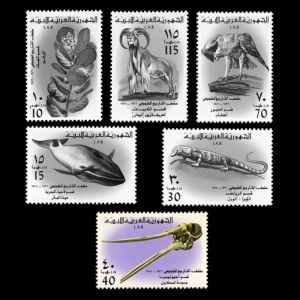 |
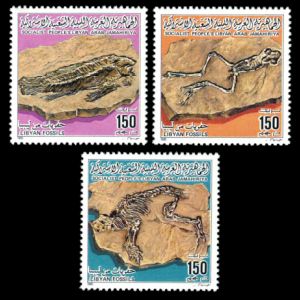 |
 |
| 25.11.1996 "Fossils of Libya" | 11.12.2013 "Prehistoric animals" | |
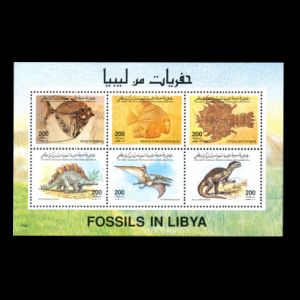 |
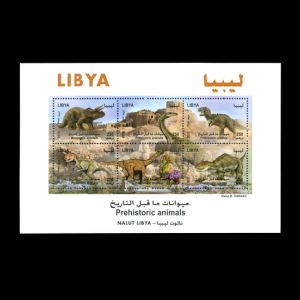 |

|
Notes:
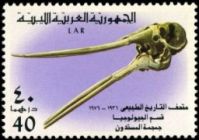
|
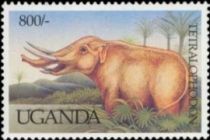
|
| Fossil of Tetralophodon on stamp of Libya 1976 MiNr.: 528, Scott: 615 | Reconstruction of Tetralophodon on stamp of Uganda 1992 MiNr.: 1070, Scott: 1002 |
Notes:
[1] Skull of Tetralophodon longirostris is shown on stamp with face value 40D.
Tetralophodon was an elephant-like animal which existed through the late Miocene to the Middle Pleistocene epochs, approximately 10.9 million years ago.
Tetralophodon had four tusks and a trunk.
In fact, this animal also had two more tusks protruding from the jaw.
Their fossils have been found from the late Miocene to the Middle Pleistocene epochs of Europe, Asia, and Africa. [R3]
[2] This set shows a mix of reconstructions of prehistoric animals painted by famous paleo-artists including J. Sibbick, Z. Burian, S. Serkas and M. Hallett. [R4]
References:
- [R1] Libya:
Wikipedia,
WikiTravel,
FlagCounter.
- [R2] Postal History and Philately of Libya:
Wikipedia,
Links to official website of the Post Authority, stamp catalog and a list of new stamps of Libya are here - [R3] Tetralophodon: Wikipedia.
- [R4] Prehistoric animals stamps from 1995: stampedout.
Acknowledgements:
Many thanks to Dr. Peter Voice from Department of Geological and Environmental Sciences, Western Michigan University, for reviewing the draft page and his valuable comments.
| << previous country | back to index | next country >> |